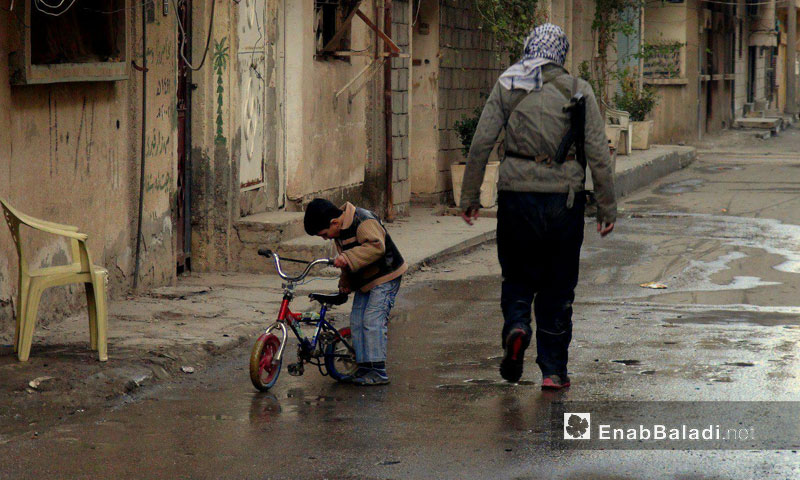



“To me, these people stand for fear only. By just seeing them, I leave the place,” says Abu Hassan (38 years), displaced from Deir ez-Zor and currently based in rural al-Hasakah, justifying his and other people’s fear of the “Islamic State” (IS) group’s cells in the eastern region of Syria.
Abu Hassan was displaced from his city at the end of 2012, in his interview with Enab Baladi, he says that he observed dozens of former “IS” fighters, freely roaming different parts in al-Hasaka, “I never thought that I will be seeing them alive and free after the Group has ended.”
Fear forced Abu Hassan to hide in his house for days. He remained thus until he decided to sell all that he owned, including his house’s furniture and his small shop to leave the area, where he lived for six years. “These people carry destruction wherever they go; their sight has become ominous,” he stresses.
Most of the people interviewed by Enab Baladi pointed out to “IS” elements who have been roaming the area, which “Syrian Democratic Forces” (SDF) has controlled during months of battle in the past year. Some people said that the elements included former leaders, administrators and religious figures in “IS” Group, expressing worries and panic of sleeper cells that might come to life later on.
“Are these elements static; have they cut all ties to IS; have they relinquished their former beliefs; who is watching them, or do they go non-watched?” These are questions, which the area’s people propose and to which no one is forwarding an answer. Some of these elements are close to the “Kurdish Self- Management” affiliated to the Kurdish “Democratic Union,” who is running the area. Others have denied the existence of these elements.
In the areas under “SDF,” many families fear the exploitation of the situation as to impose a fresh wave of displacement, on the pretext that, in the upcoming period, “terrorist operatives” would be implementing repetitive operations.
The elements of “IS” are spread in the eastern region, within the points controlled by “SDF,” in an enclave of about 400 square kilometres at the Syrian-Iraqi borders, despite the fact that “SDF” has already announced the total annihilation of “IS”.
“That who raises scorpions must have a share of their stings,” according to Abu Qassim (30 years), displaced from Deir ez-Zor and living in al-Hasakah for five years.
The young man tells Enab Baladi that “SDF’s leaders might be attempting to exploit these elements to indulge them in political plans as a pretext against Arabs in the area to label them with terrorism or pass certain Agendas.”
Abu Qassim was prevented from teaching after he refused to teach the Kurdish curricula imposed by “Kurdish Self-management,” he added that “any call by extremist elements would find a fertile soil, especially with the Arab people’s furry at the activities of the ruling authority.”
He confirms that “it doesn’t matter what reason do they have to be in the area; at the end, the biggest loser is the civilians,” pointing out that “SDF’s” elements used to apply a stricter form of observation in the area, prior to getting rid of “IS,” which confused him.
Activists from the area say that these elements are trained and prepared for the future; they also do supply “IS’s” groups, outside “SDF’s” control points, with light and medium weapons.
According to Arab Activists, whom Enab Baldi interviewed, the security risks are “actual.” They are sacred for the people who have recently escaped the regions under “IS” and are searching for a safe place to shelter them, “so those who have been forced to stay close to “IS” and have been deeply harmed due to this would not be stigmatized as terrorists.”
Abu Tariq (34 years), a member of the Arab tribes in al-Hasakah, volunteered to work for “SDF,” telling Enab Baladi that “not everyone who joined the Group is a believer in its ideas, they volunteered either in anticipation of money and fame, or in search of safety and the prevention of the Group’s evils.”
The man negates all that the people have been discussing, expressing his surprise at what the people and activists are saying, there is a big contradiction, “sometimes they demand to help and release the people besieged by IS and on other times they accuse SDF of incubating IS’ elements.”
The security and judicial systems in the “Kurdish Self-management” carry out the task of investigating suspects and “IS’” elements, according to Abu Tariq. He points out that some of these people are training with “SDF,” they belong to the people who have proven their faith in the ideas of the democratic state.
He pointed out that some of those released “came out on the condition that there are no criminal proceedings against them,” adding that “the areas that are now out of IS’ control are safer than the areas under Assad’s forces, and that people do prefer to stay in IS’ areas rather than going to the regime’s”.
if you think the article contain wrong information or you have additional details Send Correction